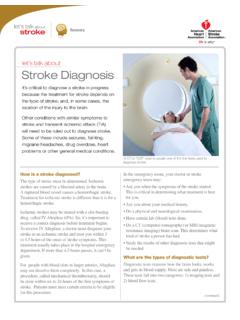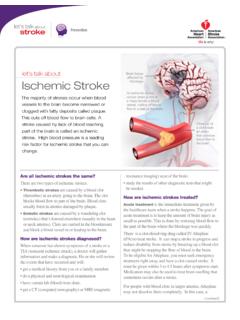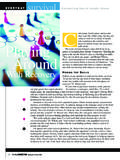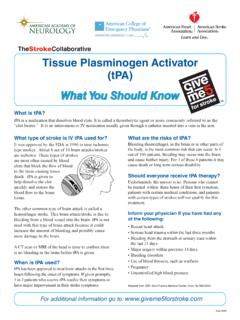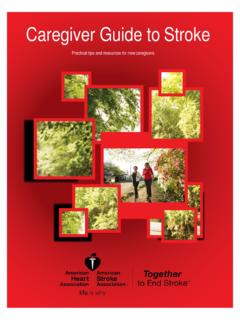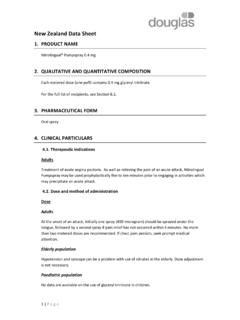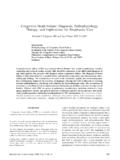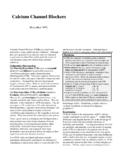Transcription of DILATED CARDIOMYOPATHY - Stroke Association
1 DILATED CARDIOMYOPATHYD ilated or congestive CARDIOMYOPATHY (DCM) is diagnosed when the heart is enlarged ( DILATED ) and the pumping chambers contract poorly (usually left side worse than right). A diagram and echocardiogram comparing a normal heart and a heart with DCM are shown in figure 1a and figure condition is the most common form of CARDIOMYOPATHY and accounts for approximately 55 60% of all childhood cardiomyopathies. According to the pediatric CARDIOMYOPATHY registry database, this form of myopathy is detected in roughly one per 200,000 children with roughly one new case per 160,000 children reported each year in the United States. It can have both genetic and infectious/environmental is more commonly diagnosed in younger children with the average age at diagnosis being 2 years. DILATED CARDIOMYOPATHY can be familial (genetic), and it is estimated that 20 30% of children with DCM have a relative with the disease, although they may not have been diagnosed or have and symptoms of DCMD ilated CARDIOMYOPATHY can appear along a spectrum of no symptoms, subtle symptoms or, in the more severe cases, congestive heart failure (CHF), which occurs when the heart is unable to pump blood well enough to meet the body tissue needs for oxygen and only subtle symptoms exist, infants and young children are sometimes diagnosed with a viral upper respiratory tract infection or recurrent pneumonia without realizing that a heart problem is the basis for these symptoms.
2 Older children and adolescents are less likely to be diagnosed with viral syndromes and more likely to present with decreased exercise capacity or easy fatigability. With CHF, babies and young children will usually have more noticeable clinical changes such as irritability, failure to thrive (poor gain weight), increased sweating especially with activities, pale color, faster breathing and/or wheezing. In older children, congestive heart failure can manifest as difficulty breathing and/or coughing, pale color, decreased urine output and swelling, excessive sweating, and fatigue with minimal activities. Until the diagnosis is made in many children, chronic coughing and wheezing, particularly during activities, can be misinterpreted as patients with DCM caused by viral myocarditis (weakened, enlarged heart muscle usually due to a viral infection) can have a rapid increase in the number and severity of CHF symptoms such that within 24 48 hours the child can become very ill requiring emergency hospitalization, and occasionally, advanced life due to heart rhythm problems (or arrhythmias, which means irregular, fast or slow heart rates) can also be either the first symptom or a symptom that appears after other symptoms have led to a diagnosis of DCM.
3 Symptoms of rhythm problems include palpitations (feeling of funny or fast heart beats), syncope (fainting), seizures (convulsions), or even sudden cardiac arrest (heart stops beating effectively requiring resuscitation). These symptoms can occur at any age and with any stage of CARDIOMYOPATHY , even if other more severe symptoms of congestive heart failure have not yet appeared. Figure 1b- Multiple echocardiographic views of a normal heart on the left and a heart with DILATED CARDIOMYOPATHY on the right. Note the increased dimensions of the left ventricle with the thin walls of the left ventricle (LV).Figure 1a- A normal heart is shown on the left compared to a heart with DILATED CARDIOMYOPATHY on the right. Note the increased dimensions of the left ventricle. American Heart AssociationDiagnosis of DCMOnce there is clinical suspicion based on the patient history and physical exam, the diagnosis of DCM is primarily based on echocardiography.
4 With this test, your physician will be using ultrasound beams to evaluate the heart looking for DILATED chambers and decreased pump function. Along with the echocardiogram, there are other tests that will likely be done to confirm the diagnosis or provide clues as to the chest X-ray will show the heart size and can be used as a reference to follow increases in heart size that may occur over time. An electrocardiogram, or EKG, records the electrical conduction through the heart and is used to look for evidence of thickened or enlarged chambers as well as abnormal heart beats that can occur in children with this diagnosis. To more completely evaluate for the presence or absence of these abnormal heart rhythms, which may effect treatment, your doctor may also order a Holter monitor which records heart beats over a 24 48 hour period.
5 A treadmill test can also be useful in some children (beyond age 5 7 years) who can cooperate with this study. This exercise test is used to assess the energy reserve of your child s heart and, in cases when children do not respond adequately to medicines, this test may also help predict the need for heart on your child s age, a battery of blood tests may be done in order to identify treatable causes for the CARDIOMYOPATHY . This may include testing for certain viral infections such as adenovirus and the Coxsackie viruses as they have been associated with DCM especially in younger children. In many cases, no cause is discovered, and the CARDIOMYOPATHY may be referred to as idiopathic (cause unknown). Many heart failure specialists believe this idiopathic form of the CARDIOMYOPATHY is genetic. While genetic screening has not yet become a standard procedure, some physicians may send blood to molecular testing labs located in a few centers around the country so that limited genetic testing can be performed looking for possible mutations currently known to cause DILATED CARDIOMYOPATHY .
6 If your physicians believe the cause is genetic (especially common in older children and adolescents), evaluation, usually with echo, of other family members is recommended to rule out presence of this disease in other close relatives (parents, siblings).Finally, in more advanced cases of DCM, cardiac catheterization may be performed. During this procedure, a catheter (thin plastic tube) will be slowly advanced through an artery or vein into the heart (while watching its course on a TV monitor) so that pressures within the heart chambers can be measured. A cardiac biopsy, which involves removing tiny pieces of heart muscle for inspection under the microscope, may be performed to help distinguish between infectious and genetic causes. The information provided during the catheterization may also be helpful if transplantation is being considered as one of the treatment options for your child.
7 American Heart AssociationCauses of DCMW hile other causes of DCM have been identified and are briefly discussed in other sections of this brochure, mounting scientific evidence is beginning to suggest that individual genetic mutations may be among the more common causes of DCM in children. For a greater understanding of the basics of human inheritance patterns and a more detailed discussion of the potential genetic causes of DCM, the reader is encouraged to read separate sections entitled Overview of Inheritance and Genetics of Cardiomyopathies printed elsewhere in this TreatmentCurrently, there are no therapies that can cure DCM; however, many treatments are available that can improve symptoms and decrease risk in children with DCM. The choice of a specific therapy depends on the clinical condition of the child, the risk of dangerous events and the ability of the child to tolerate the therapy.
8 In the following sections, current medical and non-medical therapies for DCM are summarized. Medical TherapyThe majority of children with DCM have signs and symptoms of heart failure. The most common types of medications used to treat heart failure include diuretics, inotropic agents, afterload reducing agents and , sometimes called water pills, reduce excess fluid in the lungs or other organs by increasing urine production. The loss of excess fluid reduces the workload of the heart, reduces swelling and helps children breathe more easily. Diuretics can be given either orally or intravenously. Common diuretics include furosemide, spironolactone, bumetanide and metolazone. Common side effects of diuretics include dehydration and abnormalities in the blood chemistries (particularly potassium loss). Inotropic Agents are used to help the heart contract more effectively.
9 Inotropic medications and are most commonly used intravenously to support children who have severe heart failure and are not stable enough to be home. Common types of inotropic medications include: Digoxin (taken by mouth): improves the contraction of the heart. Side effects include low heart rate, and, with highblood levels, vomiting and abnormal heart rhythm. Dobutamine, dopamine, epinephrine, norepinephrine (intravenous medications given in the hospital): medications thatincrease blood pressure and the strength of heart contractions. Side effects include increased heart rate, arrhythmiasand for some, constriction of the arteries. Vasopressin (intravenous medication): increases blood pressure and improves blood flow to the kidneys. Side effectsinclude excessive constriction of the arteries and low sodium.
10 Milrinone (intravenous medication): improves heart contraction and decreases the work of the heart by relaxing thearteries. Side effects include low blood pressure, arrhythmias and Reducing Agents reduce the work of the heart by relaxing the arteries and allowing the blood to flow more easily to the body. Common afterload reducing medications include: Angiotensin converting enzyme inhibitors (ACE inhibitors): captopril, enalapril, lisinopril, monopril (taken by mouth). Sideeffects include low blood pressure, low white blood cell count, high potassium levels and kidney or liver abnormalities. Angiotensin I Blocker: Losartan (taken by mouth). Side effects include diarrhea, muscle cramps and dizziness. Milrinone is an inotropic agent (see above) that also relaxes the slow the heartbeat and reduce the work needed for contraction of the heart muscle.

